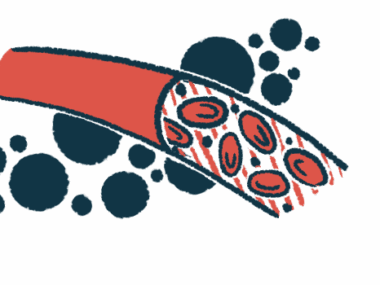Could mold have triggered my husband’s ankylosing spondylitis?
A columnist looks at autoimmune disease and mold exposure
Written by |

I’ve heard of plenty of different triggers that people believe have caused the onset of their ankylosing spondylitis (AS) symptoms, but I’d never considered mold as a possible culprit until a recent online conversation.
One of my favorite AS Facebook groups raised the question of whether mold exposure relates to autoimmune diseases, and the topic immediately caught my husband Dave’s attention. Both Dave and I were diagnosed with AS, but we had different journeys to get there, as my AS symptoms were triggered by childbirth and his worsened gradually over more than a decade.
“Interesting that you mentioned mold,” Dave replied in the Facebook chat. “I’ve always had a respiratory reaction to it, [with] lots of sneezing, etc., and I also lived in a moldy house in my early 20s, which is about the time my first AS symptoms appeared. But I’d never made that connection before. Thanks for sharing your story. You are not alone.”
Black mold in every corner
We’re now both in our 40s, and we met in our late teens when we were at college. I distinctly remember the student flat he was talking about, which was an old house in Christchurch, New Zealand, that he shared with two university friends.
Terrible university accommodations almost seemed like a rite of passage while we were studying. Student houses or flats were never luxurious, and I lived in plenty of freezing cold, dingy, and poorly equipped places that were barely sufficient to keep Christchurch’s freezing temperatures and damp winters at bay.
But when Dave first started getting AS symptoms, the house he was living in had black mold growing in every dark corner. You’d open the wardrobe and see black furry spots creeping up the panel behind his clothes. Mold rimmed the air vent in the kitchen. Dave’s bedroom shared a wall with an old, leaky shower, and dampness crept through the wall. Pulling Dave’s bed away from the wall to change the sheets, we were horrified to see mold thickly covering the wall behind his bed. It was insidious.
We were too busy studying, working, and socializing to do more than a quick clean — not realizing that mold can potentially cause health problems.
In explaining mold-related illness, the Autoimmune Clinic London writes that, “Mold releases mycotoxins which trigger inflammatory responses in the body, … and genetic factors contribute to the variation in individual responses.”
It was while living in that moldy house that Dave started to experience increasing neck, shoulder, rib, and sternum discomfort that never seemed to leave him in peace. He was never comfortable and was constantly squirming and stretching, not understanding at the time that his inflammation and pain might be due to an autoimmune disease like AS.
Was living for several years in close proximity to mold just a coincidence in the onset of Dave’s AS symptoms? We both wonder if that could have been an environmental factor that affected his autoimmune disease. There’s a well-known quote by Francis Collins, the former director of the U.S. National Institutes of Health, that sticks in my mind: “All illnesses have some heredity contribution. It’s been said that genetics loads the gun and environment pulls the trigger.”
I found quite a shocking example of the effect mold can have in relation to joint disease. Ankylosing spondylitis is a rheumatic disease, and a comparative study published in the journal Clinical Rheumatology in 2003 titled “Joint symptoms and diseases associated with moisture damage in a health center” discusses a fascinating link between rheumatic diseases and mold.
The study focuses on a cluster of rheumatic diseases that were found in employees working at a health center in Finland that had mold under the floor and in the walls. “It has been proposed that environmental exposures may initiate autoimmune responses,” the study notes. “All 34 subjects working at the health center had at least some rheumatic complaints.”
An earlier article from 2002 by some of the same researchers, published in the journal Clinical and Experimental Rheumatology, provides further details about the case, explaining that of the clinic’s employees, “Ten patients [had] inflammatory rheumatic diseases (three [had] rheumatoid arthritis, four [had] ankylosing spondylitis, two [had] Sjögren’s syndrome, and one [had] psoriatic arthritis). … Those working close to the wall [sustained] the worst damage.”
For now, at least Dave and I know that our family home in Australia is dry, well ventilated, and free from mold. I still wonder if Dave’s AS symptoms would have been different or less severe if he hadn’t spent years living in a house that clearly had a mold problem. Meanwhile, I’ll be keeping an eye out for any additional research on the subject.
Note: Ankylosing Spondylitis News is strictly a news and information website about the disease. It does not provide medical advice, diagnosis, or treatment. This content is not intended to be a substitute for professional medical advice, diagnosis, or treatment. Always seek the advice of your physician or other qualified health provider with any questions you may have regarding a medical condition. Never disregard professional medical advice or delay in seeking it because of something you have read on this website. The opinions expressed in this column are not those of Ankylosing Spondylitis News or its parent company, Bionews, and are intended to spark discussion about issues pertaining to ankylosing spondylitis.







Emily
This is very interesting, as I believe the apartment I lived in for 3.5 years had mold (when I moved out and went back a few weeks later to drop off the key, my nose and sinuses immediately became stuffed up - it wasn't until I had spent weeks away that I noticed the response). I moved into that apartment very healthy and it was after I moved out that my AS pains started. Something to think about for sure.
Jemma Newman
Oh wow that's good to know - thanks for sharing your thoughts Emily. It's so intetesting to piece this little potential clues together. Glad to hear you moved out of the apartment!